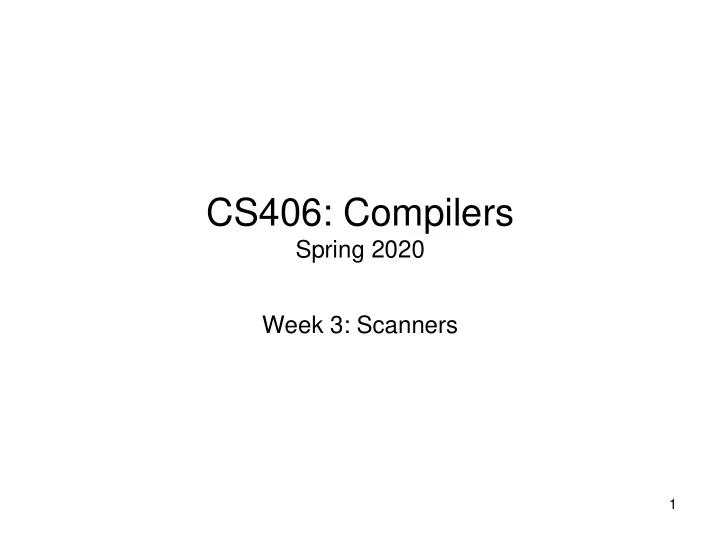

CS406: Compilers Spring 2020 Week 3: Scanners 1
Scanner - Overview • Also called lexers, lexical analyzers • Recall: scanners break input stream up into a set of tokens – Identifiers, reserved words, literals, etc. \tif (a<4) {\n\t\tb=5\n\t} if ( ID(a) OP(<) LIT(4) ) { ID(b) = LIT(5) } 2
Scanner - Overview • Divide the program text into substrings or lexemes – place dividers • Identify the class of the substring identified – Examples: Identifiers, keywords, operators, etc. • Identifier – strings of letters or digits starting with a letter • Integer – non-empty string of digits • Keyword – “if”, “else”, “for” etc. • Blankspace - \t, \ n, „ „ • Operator – (, ), <, =, etc. • Substrings follow some pattern 3
Exercise • What is the English language analogy for class ? • How many tokens of class identifier exist in the code below? for(int i=0;i<10;i++){\n\ tprintf(“hello”); \n} 4
Scanner Output • A token corresponding to each lexeme – Token is a pair: <class, value> A string / lexeme / substring of program text Program tokens Scanner Parser 5
Scanners – interesting examples • Fortran (white spaces are ignored) DO 5 I = 1,25 DO 5 I = 1.25 We always need to look ahead to identify tokens • PL/1 DECLARE (ARG1, ARG2, . . . • C++ Nested template: Quad<Square<Box>> b; Stream input: std::cin >> bx; 6
Scanners – what do we need to know? 1. How do we define tokens? – Regular expressions 2. How do we recognize tokens? – build code to find a lexeme that is a prefix and that belongs to one of the patterns. 3. How do we write lexers? – E.g. use a lexer generator tool such as Flex 7
Regular Expressions • Regular sets: Formal: a language that can be defined by regular expressions Informal: a set of strings defined by regular expressions Strings are regular sets (with one element): pi 3.14159 • So is the empty string: λ (ɛ instead) – Concatenations of regular sets are regular: pi3.14159 • To avoid ambiguity, can use ( ) to group regexps together – A choice between two regular sets is regular, using |: (pi|3.14159) – 0 or more of a regular set is regular, using *: (pi)* – Some other notation used for convenience: • Use Not to accept all strings except those in a regular set • Use ? to make a string optional: x? equivalent to (x|λ) • Use + to mean 1 or more strings from a set: x+ equivalent to xx* • Use [ ] to present a range of choices: [1-3] equivalent to (1|2|3) 8
Examples of Regular Expressions • Digit: D = [0-9] • Letter: L = [A-Za-z] • Literals (integers or floats): -?D+(.D*)? • Identifiers: (_|L)(_|L|D)* • Comments (as in Micro): -- Not(\n)*\n • More complex comments (delimited by ##, can use # inside comment): ##((#|λ)Not(#))*## 9
Scanner Generators • Essentially, tools for converting regular expressions into scanners • Lex (Flex) generates C/C++ scanners 10
Lex (Flex) 11
Lex (Flex) lex.l lex.yy.c Lexer Compiler lex.yy.c a.out C Compiler input stream tokens a.out 12
Lex (Flex) • Format of lex.l Declarations %% Translation rules %% Auxiliary functions 13
Lex (Flex) 14
Lex (Flex) 15
Recap… • We saw what it takes to write a scanner: – Specify how to identify token classes (using regexps) – Convert the regexps to code that identifies a prefix of the input string as a lexeme matching one of the token classes • Using tools for automatic code generation (e.g. Lex / Flex / ANTLR ) How do these tools convert regexps to code? Enabling concept: Finite Automata 16
Finite Automata • Another way to describe sets of strings (just like regular expressions) • Also known as finite state machines / automata • Reads a string, either recognizes it or not • Features: – State: initial, matching / final / accepting, non-matching – Transition: a move from one state to another 17
Finite Automata • Regular expressions and FA are equivalent* a a b b a a initial state initial state state state matching state matching state Exercise: what is the equivalent regular expression for this FA? 18 * Ignoring the empty regular language
Think of this as an arrow to a state without a label 19
Non-deterministic Finite Automata • A FA is non-deterministic if, from one state reading a single character could result in transition to multiple states (or has λ transitions) • Sometimes regular expressions and NFAs have a close correspondence b a b a ≡ a(bb)+a 20
What about A? (? as in optional) 21
Non-deterministic Finite Automata • NFAs are concise but slow • Example: – Running the NFA for input string abbb requires exploring all execution paths 22 * picture example taken from https://swtch.com/~rsc/regexp/regexp1.html
23
Non-deterministic Finite Automata • NFAs are concise but slow • Example: – Running the NFA for input string abbb requires exploring all execution paths – Optimization: run through the execution paths in parallel • Complicated. Can we do better? 24 * picture example taken from https://swtch.com/~rsc/regexp/regexp1.html
Each possible input character read leads to at most one new state 25
26
27
28
Example 29
Exercise • Reduce the DFA 30
Scanner - flowchart Regular expressions NFA Lexical specification e.g. Identifiers are letter followed by any sequence of digits or letters DFA Implementation Reduced DFA 31
Implementation: Transition Tables 32
DFA Program 33
34
35
36
37
38
39
Next time 40
Suggested Reading • Alfred V. Aho, Monica S. Lam, Ravi Sethi and Jeffrey D.Ullman: Compilers: Principles, Techniques, and Tools, 2/E, AddisonWesley 2007 – Chapter 3 (Sections: 3.1, 3,3, 3.6 to 3.9) • Fisher and LeBlanc: Crafting a Compiler with C – Chapter 3 (Sections 3.1 to 3.4, 3.6, 3.7) 41
Recommend
More recommend